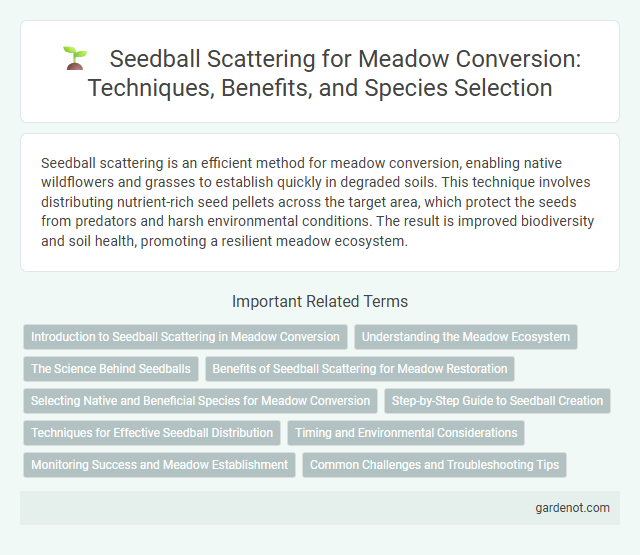Seedball scattering is an efficient method for meadow conversion, enabling native wildflowers and grasses to establish quickly in degraded soils. This technique involves distributing nutrient-rich seed pellets across the target area, which protect the seeds from predators and harsh environmental conditions. The result is improved biodiversity and soil health, promoting a resilient meadow ecosystem.
Introduction to Seedball Scattering in Meadow Conversion
Seedball scattering is a practical and efficient technique used in meadow conversion to introduce native wildflowers and grasses into an area. These seedballs contain a mixture of seeds and nutrients that protect the seeds until they reach suitable soil conditions for germination. This method promotes biodiversity, enhances soil health, and supports pollinator populations by facilitating the establishment of diverse plant species.
Understanding the Meadow Ecosystem
Seedball scattering supports meadow conversion by promoting native plant diversity and enhancing soil health. This method mimics natural seed dispersion, facilitating the establishment of wildflowers and grasses crucial for pollinators and local wildlife. Understanding the meadow ecosystem's balance highlights how seedballs contribute to habitat restoration and long-term ecological stability.
The Science Behind Seedballs
Seedball scattering utilizes a protective clay and compost coating that shields seeds from predators and harsh environmental conditions, enhancing germination rates. This method improves seed-soil contact and moisture retention, crucial for successful meadow conversion. Research demonstrates that seedballs facilitate biodiversity by enabling seeds to establish in degraded soils where traditional sowing methods often fail.
Benefits of Seedball Scattering for Meadow Restoration
Seedball scattering enhances meadow restoration by promoting native plant diversity and improving soil health through natural germination processes. This method protects seeds from predation and desiccation, increasing germination rates and establishing robust vegetation cover. Seedballs facilitate cost-effective, large-scale reseeding, accelerating habitat regeneration and supporting pollinator populations.
Selecting Native and Beneficial Species for Meadow Conversion
Selecting native and beneficial species for seedball scattering ensures successful meadow conversion by promoting local biodiversity and ecosystem resilience. Native plants adapted to the specific regional climate and soil conditions enhance pollinator habitats and support wildlife food webs. Incorporating a diverse mix of grasses, wildflowers, and legumes optimizes soil health and sustains long-term meadow vitality.
Step-by-Step Guide to Seedball Creation
Seedball creation begins by mixing native wildflower seeds with clay, compost, and water to form a malleable dough. Roll the mixture into small balls, approximately 2-3 cm in diameter, allowing them to dry for 24-48 hours until hardened. These seedballs can then be scattered directly onto the soil surface, promoting successful meadow conversion by protecting seeds from birds and improving germination rates.
Techniques for Effective Seedball Distribution
Seedball scattering requires precise techniques to maximize germination and coverage in meadow conversion projects. Using tools such as seedball dispensers or hand-throwing in a grid pattern ensures even distribution and reduces seed wastage. Optimizing factors like wind conditions and soil moisture during scattering significantly enhances seedball adherence and growth success.
Timing and Environmental Considerations
Optimal seedball scattering for meadow conversion occurs during early spring or autumn when soil moisture is sufficient for germination but before heavy vegetation competition begins. Ensuring the ground is free from dense leaf litter or frost enhances seed-to-soil contact, improving establishment success rates. Avoid scattering during periods of extreme heat or drought to reduce seed desiccation and maximize growth potential.
Monitoring Success and Meadow Establishment
Seedball scattering effectiveness is assessed through systematic monitoring of seed germination rates and plant diversity within the meadow area. Regular surveys track the establishment of native species and the suppression of invasive flora, indicating successful habitat restoration. Quantitative data on seedling survival and growth rates provide critical insights into the long-term sustainability of the meadow ecosystem.
Common Challenges and Troubleshooting Tips
Seedball scattering for meadow conversion often faces challenges such as uneven distribution, seed predation by birds, and low germination rates due to poor soil contact. To improve success, ensure seedballs have adequate moisture and apply them on compacted soil surfaces during early spring or autumn. Using a mix of native wildflower seeds and protective coatings can enhance germination while reducing losses from environmental stressors and wildlife.
Seedball scattering Infographic

 gardenot.com
gardenot.com